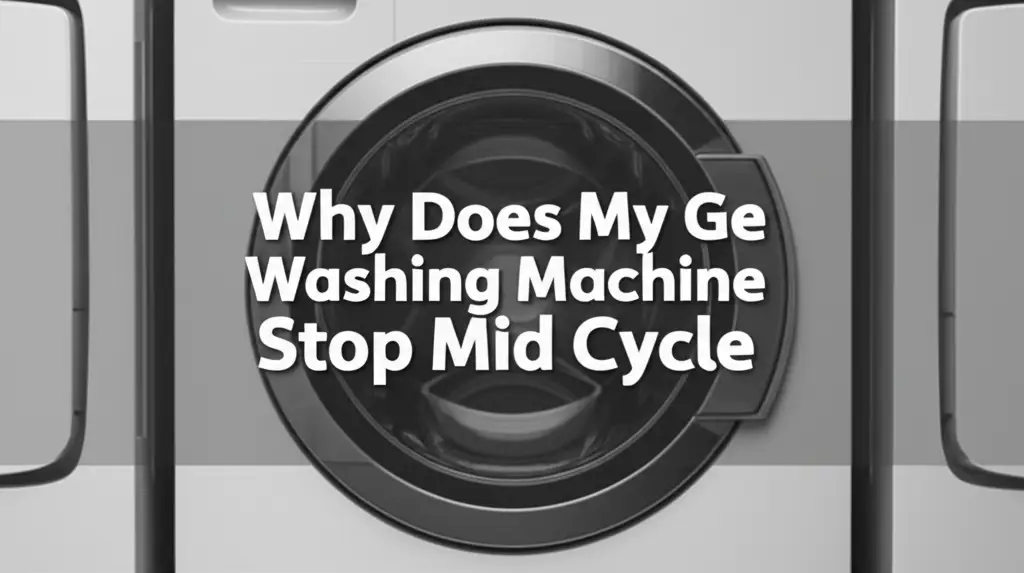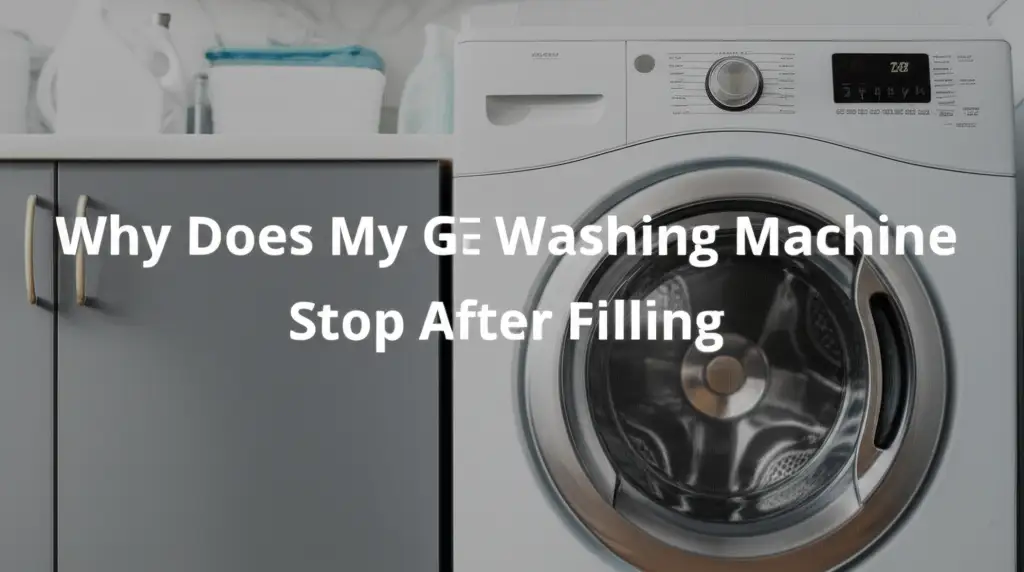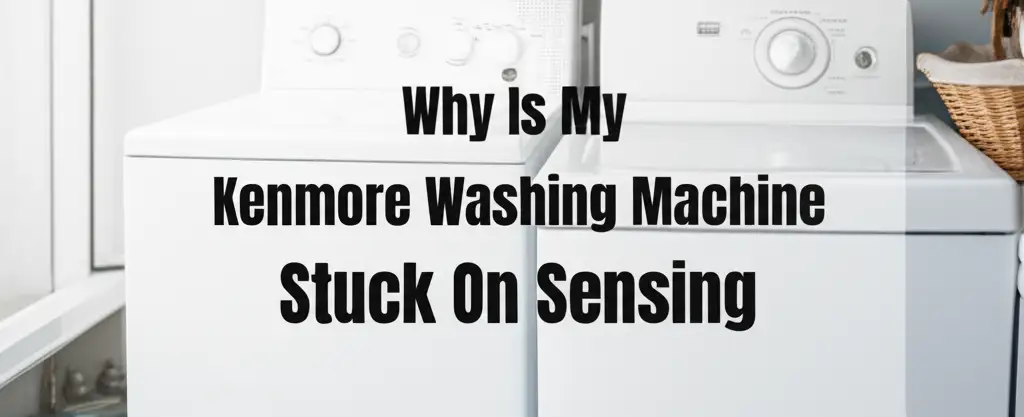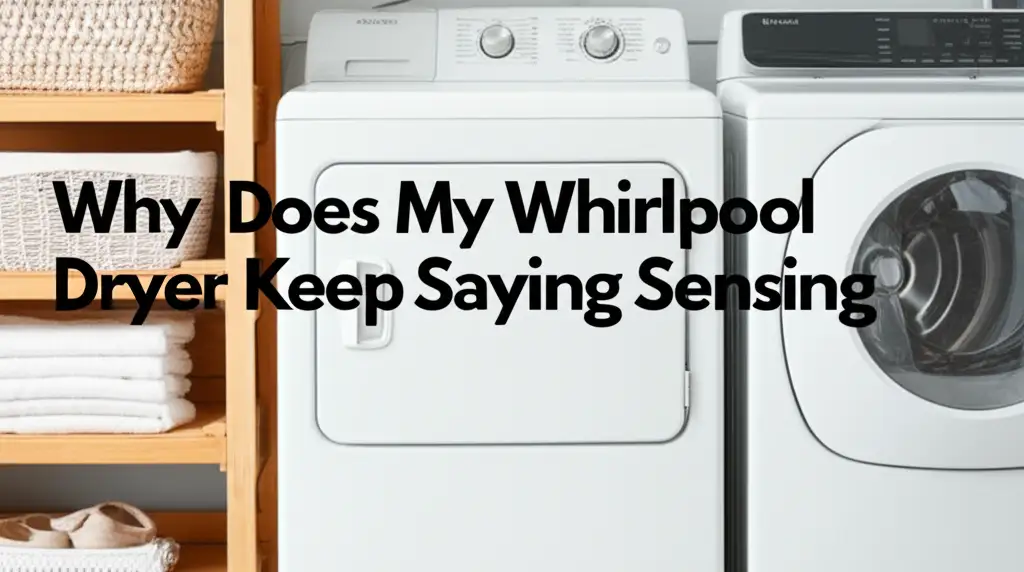· Todd Martin · Appliance Repair · 13 min read
Why Does My Ge Washing Machine Stop Mid Cycle

Why Does My GE Washing Machine Stop Mid-Cycle? Get Answers Here!
It is frustrating when your GE washing machine stops mid-cycle. You expect clean clothes, but instead, you find a paused machine and wet laundry. This common issue can disrupt your routine. Understanding why your GE washing machine stops mid cycle helps you find a solution. This guide will explore the main reasons for this problem. We will cover everything from simple fixes to more complex component failures.
Takeaway
- Check power supply and connections: Ensure your washer has stable electricity.
- Balance the laundry load: Distribute clothes evenly to prevent unbalance.
- Inspect water supply: Verify proper water flow and pressure.
- Examine drain system: Clear clogs in the drain hose or pump filter.
- Test lid switch/door latch: Confirm these safety mechanisms work correctly.
- Look for error codes: Consult your GE manual for diagnostic clues.
- Consider professional help: Some issues need expert repair.
Your GE washing machine typically stops mid-cycle due to issues like unbalanced loads, an interrupted power supply, problems with water input or drainage, or malfunctions with crucial components such as the lid switch, control board, or motor. Addressing these specific areas helps you resolve the problem.
Common Reasons Your GE Washer Stops Mid-Cycle
When your GE washing machine stops mid-cycle, it can be puzzling. I know the feeling of opening the washer door only to find standing water or half-washed clothes. Several common culprits often explain why your GE washer interrupts its cycle. These issues range from simple user errors to more significant mechanical or electrical faults. Understanding these common problems is the first step toward getting your machine back on track.
One frequent reason is an unbalanced load. If clothes clump together, especially heavy items like towels or jeans, the machine senses an imbalance. This triggers a safety mechanism to prevent damage. Another common issue relates to the power supply. A loose plug, a tripped circuit breaker, or even a power surge can interrupt the cycle. Water supply and drainage problems also frequently cause mid-cycle stops. If the machine cannot fill with water or drain properly, it will pause. We often overlook simple things first.
Unbalanced Loads and Overloading Your Machine
An unbalanced load is one of the most common reasons a GE washing machine stops mid-cycle. I have seen this happen many times in my own laundry room. When clothes become unevenly distributed during a wash or spin cycle, the machine starts to shake excessively. Modern GE washers have sensors designed to detect this vibration. They stop the cycle to prevent the machine from “walking” across the floor or sustaining internal damage. This is a safety feature.
To fix an unbalanced load, open the lid or door, redistribute the items evenly around the wash basket, and close it securely. Sometimes, adding a few more items or removing some heavy ones can help balance the load. Overloading your washing machine also contributes to this problem. Stuffing too many clothes into the tub makes it impossible for them to move freely and balance during the cycle. This creates an immediate imbalance, triggering the same safety stop. Always load your GE washing machine according to its capacity guidelines. This prevents both unbalance and wear on the machine.
Power Supply Interruptions and Electrical Issues
Electrical problems are a common cause when your GE washing machine stops mid-cycle. Your washer needs a consistent power supply to complete its operations. If this supply is interrupted, even briefly, the machine will pause or reset. I always recommend checking the simplest things first. Make sure the washer’s power cord is fully plugged into a working outlet. A loose connection can cause intermittent power, leading to mid-cycle stops.
Next, check your home’s electrical panel. A tripped circuit breaker is a frequent culprit. This happens if the washer draws too much power, or if there is a power surge. Just flip the breaker off, then on again. Ensure the outlet itself is live by plugging in another appliance. Sometimes, the problem lies with the outlet itself. If these simple checks do not reveal the issue, more complex electrical problems, like faulty wiring within the machine or a malfunctioning control board, might be at play. A professional technician might be needed for such cases.
Water Supply Problems and Inlet Valve Issues
Your GE washing machine needs a steady supply of water to complete its cycles. If the water flow is insufficient or stops entirely, your machine will pause. This is a common reason for a GE washing machine stopping mid-cycle. First, I check the water supply hoses connected to the back of the washer. Make sure both the hot and cold water faucets are fully open. If they are not, the machine cannot fill properly. Also, inspect the hoses themselves for any kinks or blockages. A kinked hose restricts water flow significantly.
Beyond the hoses, the water inlet valve is crucial. This component opens and closes to allow water into the drum. Over time, the screens inside these valves can become clogged with sediment or mineral deposits. This blockage restricts water flow. If the valve itself fails, it might not open at all or only partially. A malfunctioning water inlet valve will prevent the machine from filling correctly, causing it to stop the cycle. I have found that sometimes cleaning these filters can resolve the issue quickly. Learn more about how to clean your water inlet valve on a GE washing machine to ensure proper water flow. If your GE washer is not filling with water, it will definitely stop its cycle prematurely. You can find more information about why your GE washing machine is not filling up with water if this is your primary concern.
Drainage System Blockages and Pump Problems
Effective drainage is as important as proper water supply for a washing machine. If your GE washing machine stops mid-cycle and leaves water in the tub, chances are there is a problem with the drainage system. The machine needs to drain water between cycles and before the final spin. If it cannot, a sensor will detect the standing water and pause the cycle to prevent overflow or damage. This is a very common scenario for a GE washing machine stopping mid cycle.
The most common drainage issues involve blockages. Small items like socks, lint, or foreign objects can get lodged in the drain pump filter or the drain hose. I always suggest checking these areas first. The drain pump filter, usually located near the bottom front of the machine, collects debris. It needs regular cleaning. A clogged filter severely restricts water flow. The drain hose itself can become kinked or obstructed. Ensure it is not crushed behind the machine and that it has a clear path to the drain. If the filter and hose are clear, the drain pump might be faulty. A failing pump cannot effectively push water out of the drum, causing the machine to stop. For a detailed guide on troubleshooting and fixing drainage issues, including what to do if your GE washing machine is not draining and spinning, consult relevant resources. Also, learning how to clean your washing machine filter can prevent many drainage problems.
Lid Switch or Door Latch Malfunctions
The lid switch or door latch is a critical safety mechanism on your GE washing machine. It ensures the machine does not operate when the lid or door is open. If your GE washing machine stops mid-cycle, especially during the wash or spin phases, a faulty lid switch or door latch is a common suspect. For top-loader GE models, the lid switch is usually located under the main top, near the hinge. When you close the lid, it engages a small lever or plunger, completing an electrical circuit. If this switch is broken, worn, or misaligned, the machine will not sense that the lid is closed. It will pause or refuse to start.
Front-loader GE models use a door latch mechanism. This latch securely locks the door during operation and activates a safety switch. If the door latch is broken, loose, or fails to engage properly, the machine’s control board will not receive the signal that the door is closed and locked. This causes the machine to stop. You can often hear a distinct click when the door latch engages. If you do not hear it, or if the door feels loose, the latch may be the problem. Inspect the latch for visible damage. Replacing a faulty lid switch or door latch is often a straightforward repair.
Control Board and Motor Issues
When simpler fixes do not resolve your GE washing machine stopping mid-cycle, the problem might lie with the control board or the motor. The control board is essentially the brain of your washing machine. It sends signals to all other components, dictating when they should operate. If the control board malfunctions due to a power surge, age, or a manufacturing defect, it can send incorrect signals or no signals at all. This might cause the machine to pause, skip cycles, or stop altogether without warning. Diagnosing a faulty control board is difficult for the average homeowner and often requires a technician.
The motor is what spins the drum and agitates the clothes. If the motor fails, the machine cannot perform its washing or spinning functions. A motor can fail due to overheating, electrical issues, or worn-out carbon brushes in some models. Sometimes, you might hear a humming sound without any action, indicating the motor is trying to run but cannot. A thermal overload protector on the motor can also trip if the motor gets too hot, causing the cycle to stop. Once cooled, it may reset, but this indicates an underlying issue. These are more complex repairs. They usually need specialized tools and expertise.
Dealing with Error Codes and Diagnostic Mode
Many modern GE washing machines have diagnostic capabilities. When your GE washing machine stops mid-cycle, it often displays an error code on its digital screen. This code is your machine’s way of telling you what is wrong. These codes are invaluable for troubleshooting. I always recommend checking the display first if your machine pauses unexpectedly. Each error code corresponds to a specific problem, like a water supply issue, a drain blockage, or a faulty component.
To understand what the code means, you will need your GE washing machine’s owner’s manual. The manual contains a comprehensive list of error codes and their explanations. It also provides steps for troubleshooting each specific issue. Some GE models also have a “diagnostic mode” you can enter using a specific button sequence. This mode helps test different components and pinpoint the exact fault. While specific steps vary by model, consulting the manual is always the first step. If you do not have the manual, you can often find a digital copy on the GE Appliances website by searching for your specific model number. Understanding these codes empowers you to potentially fix the issue yourself or at least describe the problem accurately to a repair technician.
Professional Repair vs. DIY Solutions
Deciding whether to attempt a DIY repair or call a professional is a common dilemma when your GE washing machine stops mid-cycle. For many simple issues, a DIY approach is very feasible. If the problem is an unbalanced load, a kinked hose, a tripped breaker, or a clogged drain filter, you can usually fix it yourself with basic tools and some guidance. I encourage checking these simple things first. They often save you money and time. Learning how to clean various parts of your machine can also prevent issues. For example, knowing how to clean your GE washing machine properly can extend its life and prevent common breakdowns.
However, some problems are complex and require expert knowledge. If you have checked all the simple culprits and your machine still stops mid-cycle, or if you suspect a faulty control board, motor, or other electrical components, it is time to call a professional appliance repair technician. Attempting repairs beyond your skill level can lead to further damage to the machine or even personal injury. A professional has the diagnostic tools, experience, and proper replacement parts to resolve complex issues safely and effectively. Consider the cost of parts versus a new machine if the repair is major. Sometimes, replacing an old machine is more economical than costly repairs.
Frequently Asked Questions
Why does my GE washing machine fill with water but then stop?
If your GE washing machine fills with water but then stops, it often indicates a problem beyond the initial water intake. Common culprits include a faulty water level sensor, which tells the machine it has enough water when it does not. The machine may also stop if the lid switch or door latch is not properly engaged, preventing the agitation or spin cycle from starting. A drain pump issue could also cause it to pause if it attempts to drain prematurely.
What does it mean when my washer stops and flashes lights?
When your washer stops and flashes lights, it is usually signaling an error code. These flashing lights are the machine’s way of communicating a specific problem it has detected. The pattern of flashes or a displayed code corresponds to a particular malfunction, such as an unbalanced load, a drain issue, a motor problem, or a sensor error. Consult your GE washing machine’s owner’s manual to decipher the exact meaning of the light pattern or error code.
Can a faulty pressure switch cause a washing machine to stop mid-cycle?
Yes, a faulty pressure switch can definitely cause a washing machine to stop mid-cycle. The pressure switch monitors the water level inside the washing machine drum. If this switch malfunctions, it may incorrectly read the water level. It might signal that the tub is empty when it is full, or full when it is empty. This incorrect information prevents the machine from proceeding to the next cycle phase, causing it to pause or stop unexpectedly.
How do I reset my GE washing machine after it stops?
To reset your GE washing machine after it stops, first unplug the machine from the power outlet for a few minutes, typically 1 to 5 minutes. Then, plug it back in. This “hard reset” can clear minor electrical glitches or temporary error codes. For some GE models, holding down the “Start/Pause” button for a few seconds might also initiate a soft reset. Always refer to your specific model’s user manual for precise reset instructions.
Why does my GE washer stop during the spin cycle?
If your GE washer stops during the spin cycle, an unbalanced load is the most common reason. The machine pauses to prevent damage from excessive vibration. Other causes include a clogged drain pump or hose, preventing proper water removal before the spin. A faulty lid switch or door latch, a malfunctioning motor, or issues with the control board can also interrupt the spin cycle. Address drain issues or rebalance the load first.
Conclusion
It can be very annoying when your GE washing machine stops mid-cycle, leaving you with unfinished laundry. However, many common reasons are easy to diagnose and fix yourself. From balancing loads to checking power, water supply, and drain systems, you have several initial steps to take. Remember, small actions like cleaning your machine can prevent bigger problems. Always check your manual for error codes. If the issue seems complex, or involves major components like the control board or motor, it is wise to call a professional technician. Do not let a paused cycle ruin your day. With a little troubleshooting, you can often get your GE washing machine back to working order and enjoy clean clothes once again.





